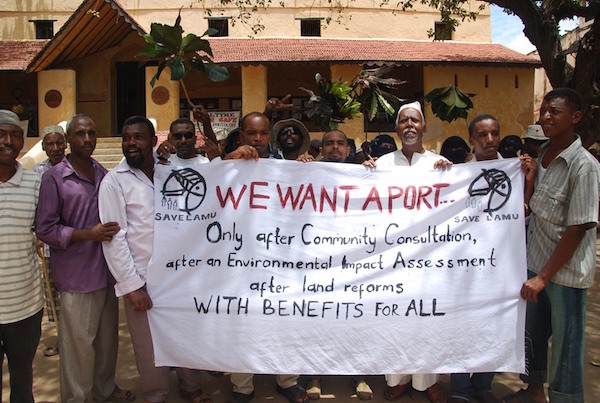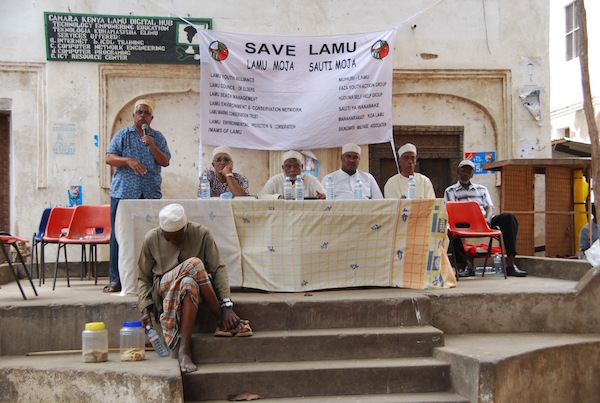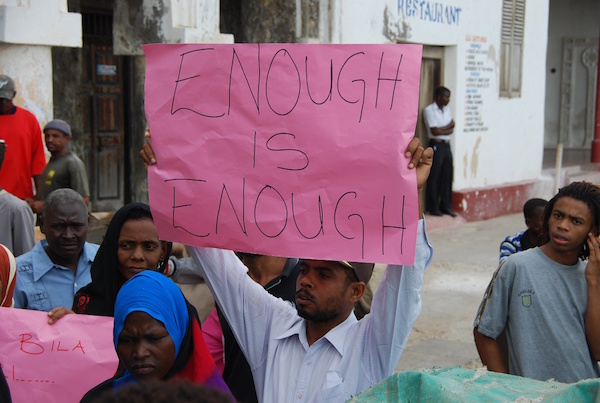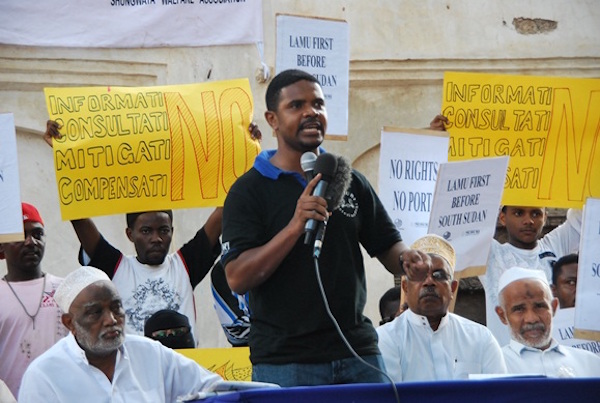News & Blogs
Supporting Diverse Communities to Respond to LAPSSET with One Voice
The following case study is an extract from Protecting Community Lands and Resources in Africa, a book of case studies that highlights land rights advocates’ innovative community land protection efforts.
By Mohamed Athman and Hadija Ernst, Save Lamu
Save Lamu is based in Mkomani ward within Lamu town, located in the Lamu Archipelago off Kenya’s north coast. Save Lamu was created out of a community initiative to unite local groups and individual residents of Lamu County in a campaign to save the Lamu Archipelago. Registered as a community based organization since 2011, it consists of representatives from community-based organization from indigenous communities who are or will be affected by the proposed infrastructure development referred to as the Lamu Port South Sudan-Ethiopia-Transport (LAPSSET) project. The Save Lamu coalition represents over thirty member organizations who work together on human and environmental rights issues in light of LAPSSET and other extractive projects, to document community concerns about these developments, to discuss and explore possible impacts and opportunities, and to find ways to mitigate negative impacts.
Save Lamu’s overall aim is to advocate for the rights of local communities to participate in decision making in development projects affecting their environment, lives, and livelihoods. They advocate to the government for information, transparency, and participation in activities relating to LAPSSET and coal, gas, and oil industries in the County. Save Lamu works with communities to build their capacity to know and realize their rights under the Kenyan Constitution and other international treaties signed by the government of Kenya. One of its objectives is to preserve the cultural integrity embedded in the lives of communities in Lamu County.

Save Lamu community members protesting about the port development in 2011. © Save Lamu
Context in Lamu County
Since Kenya’s independence, land in Lamu County has been categorized as belonging to the Kenyan Government. Land allocations to local individuals, like those done in other parts of the country, never took place. Because of this situation, the indigenous communities of the county are unjustly considered squatters on land held by the government. In the 1970s, former President Kenyatta created settlement schemes and brought landless people from Kenya’s interior to settle on the coast in Lamu County. These settler communities were allocated farmland with title deeds, while the indigenous populations remained land-insecure. Under Kenya’s new Constitution, former Government land is to be re-categorized as Public land (under the trusteeship of the County Government) or Community land under the National Land Commission, a new entity whose mandate is to issue titles and investigate illegal or questionable land allocations. This process has been stalled by the central government and there appears to be little political will to make it viable. It is within this challenging context that Save Lamu works.
In addition to the political and historical complexities, Save Lamu faces several challenges within the communities that it supports, particularly with local elites who have benefitted from previous land laws or those who have grabbed land in Lamu County. For example, powerful individuals have attempted to tarnish Save Lamu’s reputation in government circles, making it difficult for Save Lamu to engage effectively with government. Additionally, many provincial administrators have taken advantage of the marginalization of indigenous communities to grab land for themselves over the decades. This has enabled a cadre of people, both local and official, to continue to engage in corrupt practices in the County. They are not pleased to see people speaking out, organizing communities, providing legal capacity training or sharing information that exposes the blatant corruption of land allocation in Lamu County. In addition, since the introduction of the LAPSSET project, the price of land in the County has multiplied, which has escalated the situation and intensified the efforts of those who want to deface Save Lamu and others working to defend communities’ land rights.
The LAPSSET project
As currently envisaged, the LAPSSET project will be the largest transport corridor in Kenya. It is estimated that it will cost US$26 billion and consists of a number of “sub projects” including: a 32-berth Port at Manda Bay, in Lamu; inter-regional crude oil and petroleum pipelines; the development of resort cities in Lamu, Isiolo and Turkana; an international airport in Lamu; and the establishment of a railway line and inter-regional highways. In addition, in recent months, plans have arisen to construct a coal-powered generating plant in Lamu County, which would be the largest single electricity producing plant in the country. Communities in Save Lamu are concerned about the impacts of coal on the environment, health and livelihoods in the county and are keen to explore alternatives to coal such as wind and solar power. The LAPSSET project is expected to support the national economy, create jobs, and strengthen Kenya’s oil and gas industries, based in Turkana and the Lamu Basin. .
Advocating for community rights in these circumstances draws much negative attention to Save Lamu’s work. Save Lamu is often described as anti-development, which in this context has connotations of being anti-government. Indeed, only after the promulgation of the new Constitution and its devolved system of governance which established the county system of government, was Save Lamu able to engage in meaningful dialogue with local government officials. The new county government acknowledges Save Lamu and has legitimized its work to defend community rights, county rights, and land rights as being not contrary to development. The county government’s position has always been that consultation and free prior and informed consent should be engaged in with all communities hosting development projects.
Supporting Diverse Communities to Respond to LAPSSET with One Voice
Lamu’s population is over 100,000 people and includes a variety of different indigenous and ethnic groups as well as settlers who have migrated to Lamu over the years. Save Lamu works with various indigenous and traditional communities within the county, including:
- The Bajun, who are traditionally fisher folk, farmers, boat builders, tour guides and mangrove harvesters;
- The Aweer, who are traditionally hunter and gatherers but currently practice subsistence farming;
- The Sanye, the smallest and most marginalized ethnic group in the county numbering less than 500, whose traditional practices of hunting and gathering have been impeded by a lack of recognized territory;
- The Orma, a pastoralist community whose rangeland includes the County’s western area where the Tana Delta is located; and
- The Swahili, who hail from the historic urban areas of the County including the towns of Lamu, Shela, Pate and Siu, where they are merchants and farmers and more recently involved in the tourism sector.
All these communities are affected directly or indirectly by the LAPSSET project. The majority of these communities have co-existed peacefully in Lamu County. Peaceful interaction among the different traditional communities in Lamu County is also embedded in the shared religious beliefs of Islam. Islam provides a cross-cutting value system that forges links among the different ethnic groups in the county.
Lamu County’s traditional communities also share historical experiences of economic marginalization since Kenya’s independence and ongoing external threats to their territorial rights. A common narrative among these groups is the loss of traditional lands since independence, caused by settlement schemes, land grabbing by national and local elites, and the growth of the oil and gas sector which has attracted an influx of immigrants to the county and has intensified land grabbing by elites.
Government settlement schemes initiated in the 1970s by President Kenyatta, Kenya’s first president, benefited immigrant communities, predominantly Christian farmers from Kenya’s interior who came to Lamu hoping for a better life. They lived peacefully in farming enclaves on the mainland of the county and in urban areas selling fresh produce. However in June and July 2014, violence was unleashed in the county, pointedly against these populations in Mpeketoni on Lamu’s mainland. While it was predicted that this would happen if grievances around land and natural resource rights were not addressed, particularly among coastal communities, the intensity of the violence took Lamu County by surprise. There is a great need to begin a dialogue process to address not only historical injustices but also new injustices that are taking place because of the LAPSSET project and other industrial activities. The violence in Mpeketoni further highlighted the need to document the community’s history, including defining the communities that have historically shared Lamu County and acknowledge the ways that they have interacted together peacefully with their shared natural resources.
Save Lamu’s basic approach to working with communities has been the development of a Biocultural Community Protocol (BCP) in Lamu County. To create the Biocultural Community Protocol, Save Lamu engaged in the very ambitious process of uniting 45 villages encompassing various cultural and ethnic backgrounds to create one, all-encompassing advocacy document that aimed to represent all of their interests. The aim of the Lamu community’s Biocultural Community Protocol is to articulate the needs of the overarching Lamu community in light of LAPSSET, including advocating for community rights to: access to sufficient information; adequate community consultation and, where relevant, consent; and an independent environmental, social and cultural impact assessment. It has also been a very successful tool to bring different populations in Lamu together to celebrate their similarities and their common aims, instead of focussing on their differences.
The Biocultural Community Protocol concept was introduced to Save Lamu by Natural Justice – Lawyers for the Community and Environment, an NGO based in South Africa. The concept was discussed with members of the community in 2010 as a tool to address the needs of different traditional groups, to document conservation and livelihood practices and the challenges they face, and to collect the community’s own ideas of development. The communities involved in the BCP process included the Sanye and Aweer, the Orma, the Bajun, and the Swahili. Despite the differences between traditional communities in Lamu, there are many ties that bind them together. These commonalities were articulated and strengthened through the BCP process. The Lamu BCP identifies the numerous individual communities that co-exist within Lamu County and sets out the traditional knowledge and practices that each community has used to conserve the natural environment upon which they depend.
The BCP process began in 2010 and the final draft was completed in 2014. Over this time, Save Lamu met with thousands of community members from over 45 villages across Lamu County, spanning Lamu East and surrounding islands, and Lamu West, including the mainland. The BCP process enabled the community to document a number of oral histories from different communities. These oral histories provide narratives of who they are, where they come from, and help to document their traditional territories. This information is essential for understanding what resources needed to be protected and how, so as to see the continuation of community customs. The Lamu BCP process also included a number of trainings on human and environmental rights that empowered community members to: increase their awareness of their rights (under Kenyan law and regional and international legal frameworks); assert and protect their land and natural resource rights; and pursue sustainable development in Lamu County.

Lamu community members at a protest demanding fair access to information, consultation, mitigation, and compensation in the port development process. © Save Lamu
It was important to draft one unified BCP document that set out the unified visions and demands of the various traditional communities across the county and identified each of the different communities and their characteristics. This unity was essential because while each traditional community originally existed in particular parts of the county, now all live and co-exist peacefully together, depending on each other in many respects and often sharing livelihoods. Indeed, during large community meetings to write the BCP, representatives spent time in livelihood groups rather than ethnic groups. Instead of asking people to document their hopes and visions as the Bajun, Orma, Sanye, Aweer, and Swahili, they divided into groups of fisher folk, farmers, pastoralists, hunter-gatherers, and nature-based livelihoods to set out their hopes and visions for the future of their lives in Lamu.
The BCP is a tool to unify visions for the future. Separate BCPs for each community would only have served to highlight their differences, rather than celebrate their co-existence and their unified visions and demands. The Lamu BCP therefore sets out both broad, generalized information across the County as well as the uniqueness of individual communities within it.
The BCP process included:
- Articulation of community-identified issues;
- Preparation of a questionnaire to elicit required information and training of community members to engage in the participatory action research;
- Facilitation of focus group discussions to elicit specific livelihood and historical information;
- Creation of multi-stakeholder processes to better engage with external parties (and internal issues);
- Community visioning;
- Mapping of marine resources;
- Participatory video creation with community members;
- Legal training;
- Drafting of the BCP; and
- Presentation of the draft BCP to all communities for their feedback and further sensitisation of the issues.
All these steps were essential for engaging with traditional communities who have felt marginalized and without a voice. The process revealed common challenges that solidified the community’s collective identity. The process has allowed for individual communities to remember, re-engage and reassert their traditional customs and practices, including decision-making structures and practices. Rather than isolating themselves, increasing their susceptibility to the “divide and conquer” tactics often engaged in by government and companies during megaprojects, the BCP process allowed communities to relate and unite around shared livelihoods likely to be impacted by the Port project and the coal plant.
In 2012, while Save Lamu was supporting the communities to draft their BCP, the leaders of Kenya, South Sudan and Ethiopia officially launched the LAPSSET project at the proposed site of the Lamu Port. Some communities were immediately evicted without consultation or compensation, despite official promises to ensure proper process. Construction began prior to provision of an Environmental Impact Assessment (EIA) or a licence from the National Environmental Management Authority (NEMA). Very little information was made publicly available to the community of Lamu County, despite laws and national institutions that require civic engagement in infrastructure developments.
In March 2013, Save Lamu discovered that an EIA had been submitted to NEMA for public feedback with days remaining before the end of the comment period. With only two days before the expiry of the public comment period, Save Lamu launched an online campaign to extend the time available for comment on the EIA. During this campaign (including local and international petitions) hundreds of signatures were collected and complaints were lodged to a number of government departments and members of Parliament. As a result, the period to comment on the EIA was extended.
Save Lamu used the extended 30 day period to support communities to review and comment on the EIA. What community members discovered in the EIA was disappointing. The EIA only reflected an assessment of the impacts of 3 of 23 proposed berths in the port development and the report did not provide adequate mitigation measures for the environmental and social impacts of the port. The report did include a section on relocation and compensation, including a Relocation Action Plan (RAP) but its contents were not made public. The community collated their concerns and shared the EIA with interested parties locally, regionally, and internationally. This process, while time consuming, supported a robust, unified response to the EIA, particularly where technical aspects of the assessment were difficult to understand. Save Lamu and allies also insisted that a Strategic Environment Assessment Report (SEA) be developed for the whole LAPSSET project (as opposed to a small EIA on one segment of the project in Lamu) in order to understand the effects of each component and their correlated effects as a whole on all concerned communities.

Save Lamu volunteer, Is-haq Khatib, volunteering at a demonstration about the LAPSETT port development. © Save Lamu
Outcomes
Developing the Lamu County BCP provided Save Lamu a means of meeting with – and building the capacity of – communities all around the County. The BCP process allowed Save Lamu the opportunity to inform the community about LAPSSET and ensure that as much of the community as possible had the same information (despite challenges in accessing information about the project and resistance from government officers to provide such information). Save Lamu found that generally community members were not aware of what the LAPSSET project entails, what developments are planned, where it will be located, how much land it will consume, and what community benefits, if any, will be provided.
The BCP process also allowed Save Lamu to consult with the various communities on the project and receive feedback, including discussions of desired benefits of and concerns about LAPSSET and related projects Throughout the BCP process, issues surrounding rights and claims to land and resources were discussed and complaints and injustices as far back as Kenya’s independence in 1963 were vibrantly documented.
Save Lamu used the BCP process to build the capacity of local communities by increasing their knowledge about environmental and human rights laws that protect their rights to cultural and natural resources. The communities now provide grassroots information that helps Save Lamu monitor development throughout Lamu County. Communities develop evidence about human and environmental rights abuses, which Save Lamu uses to register concerns with available complaint mechanisms, particularly those of international corporations and monetary institutions involved in the LAPSSET project.
Despite Save Lamu’s heroic reclaiming of the EIA process and holding the Kenyan government to account, to date the government has not sufficiently addressed the concerns set out in the community’s response to the EIA. Despite Save Lamu’s attempts to halt the development of the Lamu Port until a sufficient EIA, mitigation plan, and community consultation process are completed, the government has implemented the initial phases of the project, although at a much slower rate than originally planned. Save Lamu and the Lamu community are continuing their multi-dimensional strategy, including advocacy, meetings, demonstrations, media campaigns, networking, and continuing to build the capacity of the Lamu community to participate in land use decisions affecting their territory.
Strategic Analysis of Save Lamu’s Approach
On many levels, Save Lamu’s work has been reactive – responding to information as it becomes available. For example, when the Lamu Port began development without an Environmental Impact Assessment, Save Lamu responded with a legal fight to demand an assessment and public comment period. Often these reactive strategies feel desperate and place Save Lamu constantly on the defensive. In contrast, the BCP process was not only an excellent method of working with affected communities, it has also allowed Save Lamu to meet with communities and gather information in a way that is positive and less threatening to the Kenyan government. As opposed to simply reacting, the acts of sensitisation, collating information, and preparing the Lamu BCP have been a proactive methodology for the community to deal with the impending port development. When published, the BCP will be a document for and by the people of Lamu County, a tool for advocating that private contractors, external actors and the Kenya Government adhere to local laws and international treaties. Even in draft form, it has already been a useful tool when engaging with expert consultants from UNESCO who are investigating the likely impacts of the port on Lamu town, which is a World Heritage Site.
One disadvantage of the BCP as a proactive tool, however, is that it can be delayed or set aside while more immediate, urgent needs are addressed. With any large-scale infrastructure project, communities are often dealing with a barrage of threats at any given time, which can distract from or delay more pre-emptive advocacy techniques like the BCP. For example, the BCP’s finalization – and various associated activities, including mapping processes – stalled after the recent massacres in Mpeketoni. The instability led to prohibitive curfews in the County, restricting movement of Lamu citizens. This has had an impact on the BCP process as well as other advocacy activities.
Another challenge has been a lack of complete inclusivity. The Lamu County BCP documents five traditional communities (the Bajun, Aweer, Sanye, Orma and Swahili), but there are other small traditional communities exist within the county, such as the Somali and Giriama, who are not included in the BCP. However, the BCP is a living document, which can be added to and changed over time, enabling more communities to be included and for the BCP to keep pace with development.
Lamu County’s BCP is now in its final draft. The list of demands in the final BCP included demands for information, consultation, consent and an adequate environmental impact assessment. These were general demands that citizens across Lamu County were also asking for. Save Lamu is hopeful that this document will strengthen the communities’ identity and ability to engage in dialogue with local, national and international development stakeholders. The BCP speaks of ways of life that Kenya’s Constitution protects and emphasises that there must be dialogue with the community if development efforts are to succeed.

Lamu community members at a protest demanding fair access to information, consultation, mitigation, and compensation in the port development process. © Save Lamu
Recommendations and Conclusion
Many lessons have been learned throughout the BCP process in Lamu. A number of recommendations can be made as a result.
First, the BCP process aimed to be as participatory as possible, hence the incorporation of data and views from 45 different communities across the county. However, the enormous amount of information that was captured (which was essential on the one hand, but on the other hand very overwhelming) meant that a large amount of time was required to compile the collated information into a format that is digestible for outsiders and for the communities themselves.
Second, the Lamu BCP has been a time-intensive process and many changes have occurred in the community during this time. The BCP process has evolved to include some changes but not others. There have been delays, on occasion, due to the need to engage in more urgent and direct advocacy strategies, such as formal legal petitions, online petitions, direct dialogue with government officials and representatives from international organisations. As described above, a BCP is not a panacea, and is one of several advocacy strategies that Save Lamu have been using to deal with the issues of LAPSSET and oil and gas development. It is recommended that the BCP process be considered one very necessary tool in a toolbox of others that a community may wish to use where such external threats are taking place.
Third, because Save Lamu is working with not only one indigenous community or livelihood group, but several cross-cutting communities, the BCP has sections that document, as best as possible, these diverse groups’ customs, links with natural resources and the impacts of LAPSSET and other developments. As a consequence, the BCP is a kaleidoscope of useful and interesting information designed for people to dip into and out of, depending which sections are of most use to them. It is useful to note that the information collected within it, directly from affected communities, has been used to inform dialogues and engagements (and strategies) with external actors, highlighting the usefulness of the BCP process generally.
Finally, throughout the BCP process and the EIA advocacy efforts, Save Lamu has learned that success does not and possibly will never mean a clear “victory.” Rather, “success” is more nuanced, through dialogue and compromise, based on respect for the constitutional laws that protect individual and community rights.

